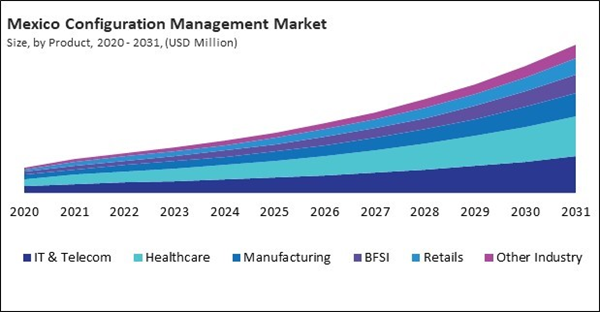The US market dominated the North America Configuration Management Market by Country in 2023, and would continue to be a dominant market till 2031; thereby, achieving a market value of $1.72 billion by 2031. The Canada market is experiencing a CAGR of 16.8% during (2024 - 2031). Additionally, The Mexico market would exhibit a CAGR of 15.9% during (2024 - 2031).
Configuration management (CM) is a process used in IT and other industries to systematically manage and control the configurations, settings, and changes of systems, software, hardware, and infrastructure components. Its primary goal is to ensure consistency, accuracy, and reliability in how systems are configured and managed over time. By maintaining a structured record of configuration states, CM helps prevent errors, minimize downtime, and ensure that changes are implemented correctly, enabling systems to function smoothly.
The configuration management market plays a pivotal role in modern IT infrastructure and systems development, offering organizations the tools necessary to track, control, and maintain consistency across various components of their technological environments. As industries undergo digital transformation, the complexity of managing IT assets, systems, and configurations has grown exponentially, making configuration management an essential process for ensuring operational efficiency and minimizing risks. From software development to hardware maintenance, configuration management allows businesses to control changes, streamline operations, and maintain their systems' stability. It is a critical function for organizations seeking to enhance their agility, scalability, and security in an increasingly digital world.
In Mexico, the manufacturing sector is a major driver of configuration management adoption. The country's push towards Industry 4.0 and smart manufacturing initiatives has led to increased digitization of manufacturing processes, including automation and IoT integration. Configuration management tools are critical in ensuring these interconnected systems remain secure and efficiently configured. The Mexican government’s National Digital Strategy, aimed at promoting digital transformation across various sectors, has further supported this trend. According to the Government of Mexico, in the first quarter of 2024, the gross domestic product of the manufacturing sector was $6.26T MX, underlining the sector's significant role in the country’s economy and reliance on digital tools. Therefore, the region will present lucrative growth opportunities for the market throughout the forecast period.
Based on Enterprise Type, the market is segmented into Large Enterprises and SMEs. Based on Asset, the market is segmented into Server Infrastructure, Cloud Resources, Network Devices, Security Devices, and Edge Infrastructure. Based on Industry, the market is segmented into IT & Telecom, Healthcare, Manufacturing, BFSI, Retails, and Other Industry. Based on countries, the market is segmented into U.S., Mexico, Canada, and Rest of North America.
List of Key Companies Profiled
- VMware, Inc. (Broadcom Inc.)
- Atlassian Corporation PLC
- Cisco Systems, Inc.
- Microsoft Corporation
- Oracle Corporation
- CloudBees, Inc.
- Puppet, Inc. (Perforce Software, Inc.)
- ServiceNow, Inc.
- Amazon Web Services, Inc. (Amazon.com, Inc.)
- NetApp, Inc.
Market Report Segmentation
By Enterprise Type
- Large Enterprises
- SMEs
By Asset
- Server Infrastructure
- Cloud Resources
- Network Devices
- Security Devices
- Edge Infrastructure
By Industry
- IT & Telecom
- Healthcare
- Manufacturing
- BFSI
- Retails
- Other Industry
By Country
- US
- Canada
- Mexico
- Rest of North America
Table of Contents
Companies Mentioned
- VMware, Inc. (Broadcom Inc.)
- Atlassian Corporation PLC
- Cisco Systems, Inc.
- Microsoft Corporation
- Oracle Corporation
- CloudBees, Inc.
- Puppet, Inc. (Perforce Software, Inc.)
- ServiceNow, Inc.
- Amazon Web Services, Inc. (Amazon.com, Inc.)
- NetApp, Inc.
Methodology

LOADING...









